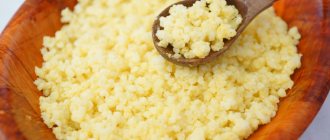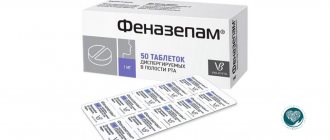Type 2 diabetes mellitus imposes certain restrictions on the patient’s lifestyle. This is especially true for nutrition - you should eat small, varied and balanced, healthy foods, giving preference to fruits, vegetables and whole grains, lean meat, fish and dairy products. Endocrinologists have also developed a special diet that divides all foods into recommended, acceptable and undesirable. Let's take a closer look at each category in our article.
Positive properties
The main criterion for the usefulness of cereals is the glycemic index, which shows the amount of sugar entering the body. For type 2 diabetes, it is recommended to consume only those cereals that have a low glycemic level, this will reduce the load on the pancreas and improve absorption of the product. The average figure ranges from 40 to 68 units.
Most cereals for diabetes serve as the main source of carbohydrates; they promote the slow breakdown of glucose, thereby preventing its sudden changes in the body.
A diabetic's diet should include various types of cereals, since they have their own specific characteristics.
Cereals in their chemical composition contain many essential vitamins, microelements, and plant proteins; they are able to replenish the body’s energy reserves and give the patient strength. For diabetics, porridge is the main part of the diet, from which you can prepare delicious dishes and thereby diversify your daily diet. When preparing dishes from cereals, you need to take into account that different methods of culinary processing can both increase and decrease the glycemic index of the product. So, boiling cereals in water is the most acceptable cooking method. To improve the taste of the finished dish, you can add 10 g of cream or 1 tbsp. l. olive oil.
The main factors that determine the usefulness of cereals for diabetes:
- normalize metabolism;
- low calorie content;
- reduce blood cholesterol levels;
- prolonged saturation of the body;
- cleansing the body of toxic substances;
- prevent the development of anemia;
- improves microcirculation in blood vessels.
Cereals for diabetes have a number of advantages, however, if the technology for preparing the product is violated, the dish can become very high in calories, which causes an additional carbohydrate load on the pancreas. This contributes to excess body weight and leads to hyperglycemia, which is a dangerous condition for the patient.
The right food package for diabetics
Meals are organized on the basis of permitted products.
Table of recommended products by category
| Fats | |
| Vegetable | Animals |
| flax seed oil, olive oil, corn oil, sesame oil | no more than 1–1.5 tablespoons of butter |
| Squirrels | |
| Vegetable | Animals |
| mushrooms, nuts | turkey, chicken, rabbit, veal, fish, eggs, seafood |
| Complex carbohydrates | |
| Cereals | Legumes |
| pearl barley, oatmeal, barley, wheat, buckwheat (limited) | beans (preference should be given to green beans), chickpeas, lentils, soybeans |
The choice of vegetables and fruits is determined by the glycemic index
The dairy component of the diet is based on the percentage of fat content of the products. Patients with type 2 diabetes are allowed:
- sour cream and cream – 10%;
- kefir, yogurt, natural yogurt, fermented baked milk – 2.5%;
- cottage cheese – up to 5%;
- acidophilus – 3.2%;
- cheeses – light – 35%, Adyghe – 18%.
Buckwheat
It takes first place among cereals that can be consumed for diabetes, but still you should not get carried away with buckwheat, since it contains up to 60% carbohydrates. However, they are easily digestible and provide constant blood glucose levels for a long time. Diabetics are not recommended to follow a buckwheat mono-diet, since the disease requires a balanced and varied diet.
The rich chemical composition of buckwheat gives it healing properties
Rational consumption of buckwheat will help restore the normal functioning of biochemical processes in the body, due to the rich mineral and vitamin composition of the cereal. It contains a minimal amount of starch and carbohydrates compared to other cereals, and the high content of protein and essential acids can replace meat products for diabetics, which are contraindicated for overweight.
Buckwheat performs the following functions in the body:
- reduces the content of “bad” cholesterol in the blood;
- protects nerve cells from adverse factors;
- promotes a gradual increase in blood sugar levels;
- prevents the development of cardiovascular pathologies.
At the moment, green (unprocessed) buckwheat is considered especially useful. The amount of useful substances in it is several times higher, since it is not subjected to a lengthy process of purification and processing. In addition, green cereals are grown without exposure to pesticides and other chemicals, which allows the beneficial properties of the product to be preserved. Before eating, this variety of buckwheat must first be sprouted. To do this, it is washed under running water, then placed in a container with gauze for 6-7 hours. After time has passed, the grains are washed again and left in the same form. Sprouted buckwheat is stored in a cool place for 3 days.
Corn grits
The second type of cereal approved by endocrinologists for diabetes, which helps normalize glucose and cholesterol in the body. Corn porridge contains fiber, which improves digestion and cleanses the intestines of toxic substances. The low calorie content of corn dishes helps the patient lose weight, but only if consumed rationally.
Regular consumption of corn grits helps prevent cardiovascular diseases
Corn grits for diabetics are a source of a number of useful substances. It contains:
- vitamins of group B, E, PP, A;
- amino acids (tryptophan, lysine, leucine);
- microelements (silicon, magnesium, phosphorus, zinc);
- alimentary fiber.
Corn-based dishes have excellent taste and will help diversify the diet of a diabetic patient.
Useful properties and chemical composition
Various types of wheat were the second most common food item in the world in 2021, after corn. Wheat area totaled 220 million hectares worldwide. The average yield worldwide is 34.0 dt/ha. On average, 2 dt/ha of seeds are used.
Cereal is a staple food for people in many countries and is of great importance for animal fattening. Durum wheat is particularly suitable for pasta production, but is practically not grown in Germany.
Regular wheat can be grown as a winter or summer cereal. The plant grows from 40 to 100 centimeters in height. In rare cases, however, the grass can grow to a height of one and a half meters. Wheat prefers warm and relatively dry climates. Although it can be grown in cooler, wetter areas, it does not produce as good a yield. The plant was one of the first cereals cultivated by people. Historical finds indicate that the plant was cultivated about 9,000 years ago. The center of former cultivation was probably in Iran, Iraq, Syria and Saudi Arabia. Around 5000 BC then wheat came to Europe.
In ancient times, the plant was first cultivated by the Romans. It was not until the 11th century AD that wheat was grown in Central Europe. The largest producers of conventional wheat are China, India and the USA. In Russia, about 26 million tons of ordinary wheat are harvested annually. The collected cereal grains are processed into flour in mills. To do this, the wheat is first ground in what is called a mill. The solid form is mainly processed into pasta.
Wheat cereal contains up to 70% carbohydrates, 12% protein, 2% fat and 12% water. The cereal consists of 2% minerals and about 2% fiber. Cereals contain magnesium, potassium, calcium and phosphorus. In addition, the porridge contains a large amount of B vitamins. Vitamin E is also included. Due to the rather low oil yield, wheat germ oil is one of the expensive oils. Butter contains 19% saturated fat. The vast majority, however, consists of polyunsaturated fatty acids. In addition, this oil contains vitamins A, B, D, E and K.
Vitamin E
Oats
Oatmeal is a dietary product that can saturate the body for a long time. It is recommended to eat it as porridge for breakfast with the addition of dried fruits. If you have diabetes, you should give preference to regular cereals, since the flakes are processed, which increases their glycemic index and reduces the amount of nutrients.
Whole oat grains contain a maximum of vitamins, microelements and dietary fiber
Oats contain the following beneficial substances:
- antioxidants (ascorbic acid, tocopherol, flavonoids, provitamins);
- microelements (zinc, phosphorus, magnesium, iron);
- vegetable fats;
- insulin (polysaccharide).
Wheat groats
Wheat dishes are considered to be the most useful and versatile; they can normalize body weight and strengthen the walls of blood vessels.
After eating wheat porridge, sugar levels in the body decrease
Wheat has the following properties:
- the level of triglycerides in the blood decreases;
- reduces blood pressure;
- maintains elasticity and tone of vascular walls;
- speeds up metabolism;
- helps cleanse the body of harmful substances;
- increases the body's defenses.
Wheat germ has pronounced healing properties, since when the grains germinate, the amount of active substances doubles. Sprouted wheat can be added to various dishes, both fresh and dried.
A special variety of wheat cereal serves as the raw material for the production of semolina, however, due to the excess carbohydrate content, it had to be excluded from the diabetic’s diet.
Possible options
To avoid difficulties in choosing products, it is advisable to develop a menu for 7 days. You can simply swap dishes as needed. Seven diabetic breakfasts:
- omelette with Adyghe cheese, cooked in the microwave;
- wheat porridge in water, with the addition of 10% sour cream (1 tbsp);
- oatmeal milk porridge with the addition of fresh berries (fruits);
- cottage cheese casserole with cinnamon and apples;
- buckwheat porridge with milk (fat content 2.5%);
- whole grain bread with Adyghe cheese and 2 soft-boiled eggs;
- toast with curd paste and fresh cucumber.
On a note. A simple recipe for curd paste: 2% fat cottage cheese needs to be punched in a blender, add chopped herbs, a little salt and spices.
Recommended soups for type 2 diabetes:
- fish soup (it is ideal to prepare this dish by combining fatty and lean varieties of fish);
- mushroom soup (you can use dry, fresh or frozen mushrooms);
- bean or lentil soup in chicken broth with herbs and vegetables;
- frozen seafood soup;
- lean cabbage soup;
- soup of sorrel and beet tops in weak beef broth;
- chicken broth with meatballs.
Main dishes that are suitable for dinner or as an addition to lunch are best prepared in a slow cooker. This will allow you to preserve the vitamin and mineral content of the products as much as possible. Possible options:
- stuffed green peppers or cabbage rolls (for minced meat: chicken breast fillet, brown rice, salt, spices);
- fish with tomatoes baked in foil;
- stewed beans with fresh tomatoes and chicken;
- chicken breast stewed with sour cream, celery stalk and onions;
- steamed turkey meatballs;
- steamed fish balls (cutlets);
- boiled fish or meat with sour cream sauce.
For sauce for fish (meat): finely chop dill in 10% sour cream, season with spices, salt, add fresh cucumber grated on a fine grater. To stir thoroughly. Two delicious and healthy recipes for dishes cooked in a slow cooker.
Stuffed zucchini
Required components:
- two young medium-sized zucchini;
- half a kilo of chicken or turkey fillet;
- onion, tomato (one piece each);
- 150 g boiled brown rice;
- 150 g sour cream (10%);
- to taste - salt, spices.
Wash the zucchini, cut off the ends, cut into three parts. Give each piece a cup shape (remove the core with a teaspoon, but not completely). Grind the fillet along with the onion in a food processor or meat grinder. Add boiled rice, salt, spices. Mix the minced meat well and fill the zucchini cups with it. Place the preparations in the bowl of the device, add the diced tomato. Dilute sour cream with water, add salt and spices, pour over zucchini. Cook for 60 minutes in the “stew” mode. When serving, sprinkle with fresh dill.
Porridge with mushrooms
You can use buckwheat or pearl barley as a basis (in the second case, the cooking time should be doubled). Wild mushrooms must be boiled first. Sauté mushrooms (150 g) in a frying pan with 2 tablespoons of hot-pressed olive oil. Transfer to the multicooker bowl. Add one grated carrot, one onion (diced), washed cereal (260 g), salt and spices. Pour in half a liter of water. Turn on the “rice, cereals” or “buckwheat” mode.
Rice
In case of diabetes, preference should be given to the brown variety of cereals; it does not undergo the process of grinding and purification, therefore it retains most of the nutrients, compared to white rice.
The shell of unprocessed rice grain contains the bulk of minerals
Properties of rice:
- strengthens the nervous system;
- cleanses the body of harmful substances;
- normalizes intestinal function;
- helps remove excess fluid from the body.
When composing the diet of a patient with diabetes, it is necessary to consider which cereals can be consumed daily and which should be excluded in order to avoid negative effects on the body.
Adverse reactions
Gluten is able to cross both the intestinal and blood-brain barriers, which has been demonstrated in rodent studies. Modern wheat, which is the most widely used and produces the best bread from a functional point of view, has greater cytotoxic and immunogenic capacity.
Neurogluten is the term used to describe various neurological disorders caused by gluten consumption, that is, those that affect any organ or tissue of the nervous system. Patients may develop serious neurological disorders due to consumption of neurogluten.








